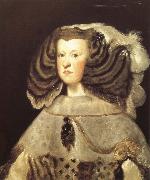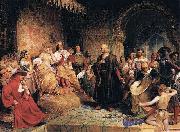Wholesale Oil Painting No Minimum |
|||||||||||
|
|
|||||||||||

|
|||||||||||
|
|
|
||||||||
VELAZQUEZ, Diego Rodriguez de Silva ySpanish Baroque Era Painter, 1599-1660 Spanish painter. He was one of the most important European artists of the 17th century, spending his career from 1623 in the service of Philip IV of Spain. His early canvases comprised bodegones and religious paintings, but as a court artist he was largely occupied in executing portraits, while also producing some historical, mythological and further religious works. His painting was deeply affected by the work of Rubens and by Venetian artists, especially Titian, as well as by the experience of two trips (1629-31 and 1649-51) to Italy. Under these joint influences he developed a uniquely personal style characterized by very loose, expressive brushwork. |
||||||||
|
|
||||||||
Queen
Queen Painting ID:: 54790 |
mk237
1652-1653
Oil on canvas
234x131.5cm
mk237 1652-1653 Oil on canvas 234x131.5cm |
|||||||
|
|
||||||||
VELAZQUEZ, Diego Rodriguez de Silva ySpanish Baroque Era Painter, 1599-1660 Spanish painter. He was one of the most important European artists of the 17th century, spending his career from 1623 in the service of Philip IV of Spain. His early canvases comprised bodegones and religious paintings, but as a court artist he was largely occupied in executing portraits, while also producing some historical, mythological and further religious works. His painting was deeply affected by the work of Rubens and by Venetian artists, especially Titian, as well as by the experience of two trips (1629-31 and 1649-51) to Italy. Under these joint influences he developed a uniquely personal style characterized by very loose, expressive brushwork. |
||||||||
|
|
||||||||
|
|
Queen
Queen Painting ID:: 54796 |
mk237
1656
Oil on canvas
64.7x54.6cm
mk237 1656 Oil on canvas 64.7x54.6cm |
||||||
|
|
||||||||
Emanuel Leutzehistorical painter, born in Gmund, Wurtemberg, 24 May, 1816; died in Washington, DC 18 July, 1868.American painter of German birth. When he was nine, Leutze's family emigrated to America and settled in Philadelphia. In 1834 he began to study art with the draughtsman John Rubens Smith (1775-1849). Leutze developed his skills as a portrait painter by taking likenesses to be engraved for publication in the National Portrait Gallery of Distinguished Americans and then working as an itinerant painter. He also experimented with imaginative compositions, such as the Poet's Dream (Philadelphia, PA Acad. F.A.). Philadelphia patrons sponsored his study in Europe, and in 1841 he enrolled at the Kenigliche Kunstakademie in Desseldorf. Although attempts at history painting won approval in Germany and in the USA, Leutze left the academy in 1843. He travelled for two years in Germany and Italy, during which time he became convinced of the importance of freedom and democracy, |
||||||||
|
|
||||||||
|
|
Queen
Queen Painting ID:: 84341 |
1843(1843)
Medium Oil on canvas
Dimensions 38 x 50 in (96.5 x 127 cm)
cyf 1843(1843) Medium Oil on canvas Dimensions 38 x 50 in (96.5 x 127 cm) cyf |
||||||
|
|
||||||||
|
Emanuel Leutze historical painter, born in Gmund, Wurtemberg, 24 May, 1816; died in Washington, DC 18 July, 1868.American painter of German birth. When he was nine, Leutze's family emigrated to America and settled in Philadelphia. In 1834 he began to study art with the draughtsman John Rubens Smith (1775-1849). Leutze developed his skills as a portrait painter by taking likenesses to be engraved for publication in the National Portrait Gallery of Distinguished Americans and then working as an itinerant painter. He also experimented with imaginative compositions, such as the Poet's Dream (Philadelphia, PA Acad. F.A.). Philadelphia patrons sponsored his study in Europe, and in 1841 he enrolled at the Kenigliche Kunstakademie in Desseldorf. Although attempts at history painting won approval in Germany and in the USA, Leutze left the academy in 1843. He travelled for two years in Germany and Italy, during which time he became convinced of the importance of freedom and democracy, Queen 1843(1843) Medium Oil on canvas Dimensions 38 x 50 in (96.5 x 127 cm) cyf |
||||||||
|
|
||||||||
|
Prev Next
|
||||||||
|
|
||||||||
|
Related Paintings to Emanuel Leutze :. |
||||||||
|
|
||||||||
|
CONTACT US |



